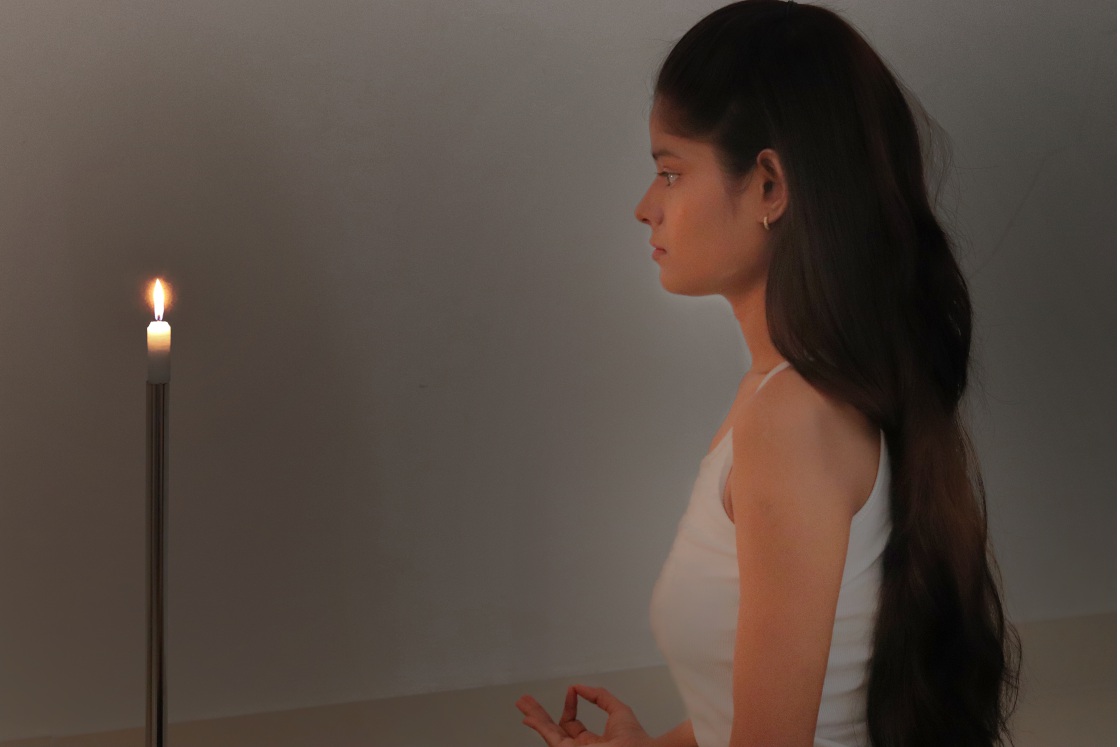
TRATAKA
- March 4, 2021
- Posted by Dr. Vaidya Karanvir Singh
- 0 Comment(s)
(Concentrated gazing)
Looking attentively with an intense gaze at a small point until tears are shed is known as trataka by the Acharya (teachers).
Trataka means to look or gaze steadily .There are two forms of the practice, one is external trataka (bahiranga) and the second one is internal trataka (antaranga) .Bahiranga is easier to practice because you just have to look steadily at an object or symbol. However, antaranga trataka involves clear and steady internal visualization of an object.
The point of concentration is usually a symbol, figure or object which activates the inner potential and can soak up the mind. The most common object used is a candle flame , because even after closing the eyes ,the image of the flame remains for some time and antaranga trataka can be easily practiced .The aim of focusing the eyes on an external object is to arouse the internal vision and to make the vision stable by ceasing the eye movements.
There are others which are equally effective symbols, figure or objects such as a crystal ball, a shivalingam, yantra, mandala, full moon, a star, the rising or setting sun (when it is orange- red ball not yellow), a chakra, the symbol of Om, or your own shadow. These are most effective; but trataka can also be done on a flower, a tree, the sea, a mountain or lightning .In fact, when people worship a particular deity or God and gaze stably at the form, it is also bahiranga trataka.
Of all the symbols and objects, the most preferably for general use is a candle flame because a symbol, yantra or mandala leaves an impression in the mind and activates particular centers. If you concentrate on Kali, you will spark that aspect of your inner being if you are not beyond it .You may even manifest kali and be terrified of her fearsome form. Therefore, a stable flame of light is most practical unless the yogic doctor says otherwise.
At a particular stage of concentration you will see a streak of light in the front of closed eyes. This has to be generated and made firm because initially it tends to waver or even vanish.
Table of Contents
Bahiranga Trataka:
(External concentrated gazing)
Practice in a dark room which is free from draughts, insects and flies. Place a candle two to three feet in front of you with the flame at the level of your eyes. It is vital that the flame is still and doesn’t flicker at all. Sit in a comfortable meditative pose, ideally siddhasana, and place the hands on the knees in either jnana mudra or chin mudra.
Close your eyes and prepare yourself as for any meditative practice .Then open your eyes and look intently at the middle portion of candle flame, just above the wick. Try to keep the eyes perfectly stable and try not to blink .Lower the eyelids if eyes become tired or sore. Gaze as long as possible, five or ten minutes, or if you can gaze longer without closing the eyes, do so.
Only when you really need, you can close your eyes. Try to keep the mind empty and unengaged. Remain the silent witness, sakshi, throughout the whole practice .When you finally close the eyes keep them fixed on the image of the flame in front, in chidakasha. If it moves bring it back to the center and continue looking until the impression vanish entirely. Practice for 10 to 15 minutes unless the yogic doctor has advised you to do it for prolong period.
Antaranga Trataka:
(Internal concentrated gazing)
Keep your eyes closed throughout the practice and concentrated on image or symbol. If you have no symbol, then try to visualize a streak of light, like a bright twinkling star or a crescent /full moon .Try to see the object precisely and steadily in the dark space in front of the closed eyes. Practice for five to twenty minutes. This practice has to be developed and it can take a long time. If the symbol has been given by the yogic guru the process will be quicker.
Time of practice and duration:
Trataka can be done at any time, but it is more effective when performed on an empty stomach .The most preferable time is between four and six a.m. after asana and pranayama practice .If you want to delve deeper into the mind, trataka should be done late at night before going to bed and before japa or meditation. If there is an unmanageable flow of thoughts during trataka, mantra japa should also be done at the same time. Beginners should gaze for one to two minutes only .For general purposes or to rectify an eye defect, trataka may be performed for longer periods .If the eyes feel strained or tired, imagine that you are breathing through the mid-eyebrow center to and from ajna chakra .When you close your eyes and look at the counter-image, continue the same sense of the breath- breathing to and from the image through the eyebrow center.
Benefits:
Trataka benefits not only the eyes, but a complete range of physiological, intellectual and mental functions. It is therapeutic in depression, allergy, anxiety, postural problems, poor concentration and memory. It brings an end to insomnia or sleeping problems. It helps in increasing eyesight. Its most important effect is on ajna chakra.
Contra-indications:
Patients of epilepsy should not practice trataka on a candle flame but they can choose a totally steady object to gaze on.

Dr. Vaidya Karanvir Singh is the younger Vaidya in Chandigarh Ayurved & Panchakarma Centre. He is the fourth generation in his family who is practicing as a general consultant in Ayurved & Panchakarma treatment at Chandigarh. In his practice, he had treated more than 1 Lakh Plus patients worldwide.

